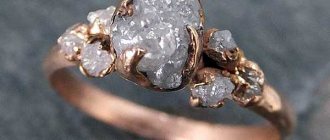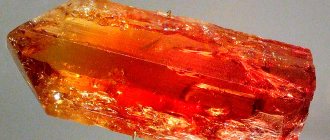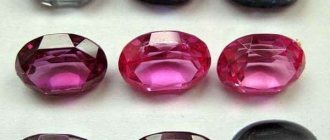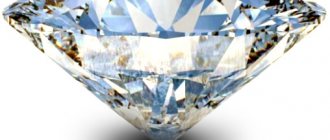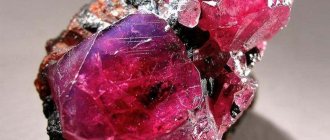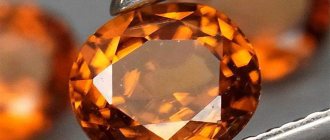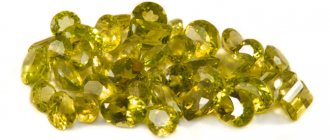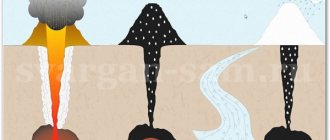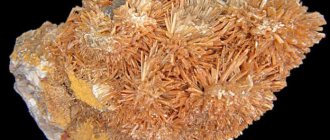| Stone type | Precious |
| Prevalence (Deposits) | Australia, Brazil, Kazakhstan, Canada, Russia, USA, South Africa |
| Varieties | Ballas, Bort, Diamond, Carbonado, Yakutite |
| Transparency | Transparent |
| Shine | Glass |
| Mohs hardness scale | 10 |
| Chemical composition | WITH |
| Color | White, blue, yellow, green, red, pink, blue, black |
| Owner's color type | Summer |
| Owner's temperament | Choleric |
| Names | Venus, Daria, Ivan, Ilya, Inna, Karina, Christina, Leo, Maria, Olympics, Sergey, Eduard |
| Zodiac sign | Aries, Leo, Sagittarius |
| Date of Birth | from March 21 to April 19 from July 23 to August 21 from November 22 to December 21 |
| Chinese horoscope | Rat, rooster, tiger |
| Element | Fire |
| Planet | Not found |
| Day of the week | Monday, Friday, Saturday, Sunday |
| Month | April, October |
| Season | Spring, autumn |
| Numerology vibration | 4, 6, 9 |
| Chakra | Sahasrara |
| What stones is it compatible with? | Agate, alabaster, amethyst, white pearl, beryl, turquoise, emerald, coral, lapis lazuli, sapphire, carnelian |
| What stones is it not compatible with? | Malachite, marcasite, obsidian, onyx, sardonyx |
| Therapeutic effect (problems) | Blood pressure, insomnia, immunity, nervous disorders, stress |
| Therapeutic effect (on organs) | Skin, respiratory organs, gastrointestinal tract organs, cardiovascular system |
| Magic properties | Strengthening relationships, finances, black magic, energy depletion |
Diamond is a unique stone that has always aroused human interest. It is called the king of all minerals, the hardest, the most expensive, etc. However, it did not immediately receive recognition; because of its extraordinary hardness, diamond cutting began only at the beginning of the 15th century. It seems colorless at first glance, but if you look closely it plays with thousands of shades. This mineral is the personification of strength and power; many legends and interesting facts are associated with it. Before you buy a diamond stone, you need to study its amazing properties.
Diamond history
The first mention of diamonds dates back to the 3rd millennium BC. Hindus were convinced that the mineral united earth, water, air and energy. They mined different types of diamonds at a time when the Greeks had just learned to extract iron from ore. The uncut stone did not look particularly attractive, so it was not particularly popular.
In the Middle East, they learned about the diamond thanks to Alexander the Great. The great conqueror brought many such stones after his campaign against India.
Only after a millennium and a half did the diamond turn into a diamond. It was first processed in the Flemish region (Belgium). It was Flemish jewelers who developed the round cut, consisting of 57 facets, which is still used today.
In Europe, jewelry with diamonds became popular in the 15th century, and in Russia - after another 2 centuries. It was during this period that the level of technological development made it possible to process the stone so that it showed all its beauty.
Since diamond is the hardest stone on earth, all its names were associated with this property. The Greeks called it “adamas”, “adamantus”, the Romans - “diamant”, the Turks - “al mas”. The familiar name “diamond” comes from the Turkic. The above names are translated as “solid”, indestructible, eternal.
This is interesting! There are many historically famous nuggets. The Indian Kohinoor diamond, weighing 800 carats, was in the possession of the Persian rulers, the Indian king, and then it was presented to Queen Victoria. The famous Orlov crystal has come a long way from India to Russia. Then Count G. Orlov presented it to Catherine II. Now it adorns the golden scepter in the Diamond Fund of Russia. “Cullinian” is a giant gem weighing 3106 carats, which, after unsuccessful processing attempts, was divided into 105 small crystals. The “Little Star of Africa” (317 carats) now adorns the crown of Great Britain.
The most famous diamonds
Diamond Kohinoor
the most famous diamond today is the Kohinoor. In Farsi it means “Mountain of Light”. Legend has it that its first owner was a boy who appeared several thousand years before the birth of Christ near the Yamuna River. This was not an ordinary child, but a product of the Sun-Karna. The stone was an ornament to his embroidered cap.
It is “Kohinoor” that is the “prima” of the British crown.
Over its history, the stone has seen a lot of blood and changed its owner until it became part of the English crown. Now it is in the Tower Castle and is securely guarded. Many say that the only worthy price for this stone is the life of the one who wants to get it.
You can learn even more about what surrounds us and about the unusual side of our lives from our Telegram channel. Interesting facts and scientific humor appear there every day.
Diamond "Tiffany"
In 1877, a diamond was found in Kimberley, which became the world's largest yellow diamond. It weighed 287 carats and was sold for $18,000—unheard of money at that time. Charles Tiffany stone . The cutting took almost two years, and as a result the stone took on a quadrangular shape and shone with 89 facets.
The unusual cut of this diamond makes it very interesting.
As a result, the stone decorated the window of a store on Fifth Avenue in New York. The first person who was able to feel it on her body was the star of the movie “Breakfast at Tiffany’s” Audrey Hepburn. After that, a diamond with an unusual cut and a setting in the shape of a diamond bird went to auction, but was never sold. As a result, it became the symbol of the Tiffany&Co store.
Diamond "Black Orlov"
Another world-famous diamond is called “Black Orlov” . Initially, he was buried in one of the Indian tombs, but robbers were able to kidnap him. As a result, as the legend goes, they brought a curse on themselves and on everyone into whose hands the stone fell.
The same “Black Orlov”...
Countess Nadezhda Orlova and Princess Golitsyna are attributed to the victims of the stone. It is also customary to attribute Jay Paris to the victims, who wanted to sell the stone in New York, but for some reason jumped off the roof instead.
There are other famous diamonds that have caused a lot of problems for their owners. And all because there is a lot of money behind them, a symbol of power and simply a charming shine that “blows the roof off.” There is no need to give them a mystical meaning; it is enough to simply understand human greed and the desire for easy money, perhaps even at the cost of someone else’s life.
Precious mineral deposit
In ancient times, diamonds were mined by hand from the ground or river sediments.
According to legend, birds were used to extract gems from deep crevices. To do this, they threw pieces of meat into the gorges, which the eagles hunted for. The stones stuck to the pieces, then people took them from the birds or looked for them in the droppings. In this way they managed to find even large nuggets .
Be sure to watch: Who is alexandrite suitable for: properties, compatibility and photo of the stone
In the mid-19th century, kimberlite pipes were discovered - these are pipe-shaped channels in the earth's crust that were formed during the breakthrough of magma. They are part of ancient volcanoes, the ground part of which has been destroyed. This depression is filled with igneous rock containing diamonds. According to experts, about 90% of all reserves of gems in nature contain kimberlite pipes. They got their name from the village of Kimberley (South Africa), where they first found such a crevice and crystals in it.
The main diamond mining centers are located in the Russian Federation (Sakha Republic), South Africa (Namibia, Botswana, Angola), Brazil (Minas Gerais, Bahia). You can also find gems in Australia, the USA, Canada, and Kazakhstan. Indian diamond mines are almost exhausted.
The world diamond market is led by the three largest in South Africa, ALROSA in the Russian Federation, and Rio Tinto Group in Brazil.
Development sites: where, how many and for how long
The description of already developed deposits will most eloquently tell you where to find diamonds. In Russia there is the largest quarry with precious stones in the world - Yubileiny. It was opened in 1986, on the territory of Yakutia. Its reserve is 153 million carats.
Only slightly inferior to the Yubileiny storage facility is another Yakut deposit - Udachny Quarry. Its reserves amount to 152 million carats. Nowadays, gemstones are mined only using the underground method. You can find out more in the article “How diamonds are mined in Russia.”
Other countries have also found their own “diamond deposits”, although not as successful as in Russia. The strangest mineral deposits have been discovered in Australia. The fact is that most of the stones mined are sides.
On the other hand, this is where 9/10 of the rarest pink diamonds are mined. You can study deposits in different countries in more depth by reading the article “On diamond mining in the world.”
Properties and scope of application
The exact origin of the diamonds is still unknown. But most scientists agree that the gem appeared after the viscous mantle of the earth’s crust, which consists of silicates and oxides, cooled. At a depth of 120 - 200 km underground, carbon atoms under a pressure of approximately 50,000 atmospheres and at a temperature of 1000 - 1300 ° form a cubic lattice. Diamonds in rocks appear on earth as a result of powerful underground explosions.
This is interesting! There are also diamonds of cosmic origin. They are formed as a result of falling meteorites.
Diamond is crystalline carbon containing small amounts of calcium, magnesium, silicon, iron, etc.
The stone has the following physical and chemical properties:
- formula – C (carbon);
- color palette - transparent, yellowish, in rare cases red, orange, green, blue, black;
- Mohs hardness degree – 10;
- density – 3.52 g/cm³;
- surface shape – conchoidal;
- refractive index – 2.417;
- degree of cleavage – perfect, octahedral;
- crystal shape – flat-edged, curved;
- degree of transparency – from transparent to opaque.
As mentioned, a diamond is a crystal lattice of carbon atoms that are connected by covalent bonds. There are 4 additional atoms placed inside the figure, which make it stronger. It is thanks to this arrangement of atoms that diamond is the strongest mineral. However, despite the fact that it is very hard, the gem is quite fragile. It may crack after a strong hammer blow.
In addition, it has another important property - luminescence. When exposed to the sun, ultraviolet or x-ray radiation, the stone begins to glow in different colors.
The gemstone is used to create luxury jewelry. But first the nugget is processed. The cutting is done on a special cast iron disk, grinding eliminates various irregularities on the surface, then the crystal is polished to obtain a mirror shine. Untreated gems looked inconspicuous, so they were not framed. White or yellow gold, as well as platinum, perfectly complement the sparkle of diamonds.
Diamond stone.
Properties of diamond. Description of the diamond. Diamond is perhaps the most popular, most precious stone in... Published by the Diamond House “Lizard” Wednesday, January 16, 2013
There are many diamond cutting techniques, but the classic one, with 57 facets, makes the stone shine the brightest. However, this technique cannot be applied to all crystals; for example, for small crystals, a cut in the form of a rose, oval or pear is used. The type of cut is selected taking into account the shape and size of each specimen.
There are jewelry and technical stones. The first are transparent diamonds or specimens with a slight tint of medium and large sizes, and the second are small dark crystals. Jewelry varieties are less common than technical varieties.
About 80% of all diamonds that are mined are used in the electronics and instrument-making industries, medicine, telecommunications, and mining. They are used in fast particle counters, scalpels, laser machines for cauterizing cuts, glass cutters, etc. Industrial diamonds are needed during space research and studying the structure of the Earth.
Be sure to see: The many faces of natural beryl: varieties, properties, photos
Shining diamonds are used to create jewelry. They are more valuable than gold. This is due to the fact that such stones are rare.
This is interesting! On average, 5 kg of diamonds are extracted from 100,000 tons of rock.
Technological “helpers”
The search for diamonds can begin with the study of magnetic fields. The fact is that a tense pulse appears above the kimberlite pipes. But to be able to detect a mineral, you will need a high-quality magnetometer. It is recommended to carry out exploration at the maximum relief height.
When studying deposits at depth, some difficulties arise. To clarify the source of the radiation, excavations are required. Problems can also arise when exploring wetlands - young silt can cause magnetic radiation similar to the device’s reaction to diamonds.
A metal detector is suitable for identifying deposits. But the device must operate at high frequency. The search engine does not respond to carbon formations themselves. But it perfectly calculates the rocks surrounding it. We talked about them above.
Kinds
The most famous is the classification of diamonds by color:
- yellow - approximately 0.05% of nitrogen atoms replace carbon elements in the lattice. Dark yellow crystals are especially valuable. Shades range from light yellow to dark brown;
- blue – contains an admixture of boron;
- blue - also contains a small amount of boron atoms. These are very rare and expensive specimens;
- green – the presence of sulfide impurities in the composition;
- red – contains chromium atoms. This is the rarest type of diamond;
- pink – there are no foreign atoms in the crystal lattice. The reasons for the appearance of this shade are unknown;
- white – contains only carbon atoms. A pure white diamond is rare.
Pure black diamonds are extremely rare, contain few inclusions, are translucent and are expensive. Their color is explained by the presence of graphite, magnetite and hematite.
In addition, there are the following types of diamonds:
- A diamond is a gem obtained after processing, which has 57 facets, its brilliance is dazzling.
- A bead is a granular formation of irregular shape.
- Ballas is a spherical crystal that has a radial-radiant structure.
- Carbonado is a fine-grained, porous aggregate of a gray, greenish or black hue.
There are also dark-colored diamonds called “Yakutite”, which contain many inclusions and are extremely hard.
Would you like to find a diamond nugget?
Not really
Is there anything harder in nature?
The hardness of diamond stone has long been known, and it is believed that it has no equal in this regard. However, curious humanity has long been asking the question: maybe there is some kind of rock or other minerals in nature that could compete with a diamond in terms of its legendary “indestructibility”?
I would like to immediately assure everyone who is interested: diamond is the hardest mineral, and there really is no equal to it in this area. It fully lives up to its name, and only it itself can become harder if it is processed using a special method.
What determines the hardness for which diamond stones are so famous? This indicator directly depends on the composition of their crystal lattice. If the crystal lattice is processed using a certain method, removing all possible defects from it, then it is possible to obtain a new laboratory substance called “hyperdiamond” synthetically. This is a diamond whose crystal is so perfect that its strength is eleven times that of natural material. The basis was the type of durable “lattice” that was given to scientists by a rare variety of diamond called “carbonado”: a black stone. About the black diamond →
As you know, ordinary single-crystal (or single-crystal) diamonds are imperfect and have many natural flaws and cracks. It happens that they cannot withstand very high temperatures and pressure. But after specialists were able to reproduce the polycrystalline structure of carbonado in laboratory conditions, we can say with confidence that there is definitely no stone harder than such a material. It can be used to create products of a wide variety of sizes and shapes, which are extremely resistant to any temperature conditions.
Medicinal properties
As a rock of igneous origin, diamond has powerful energy. The stone heals the body, normalizes its functioning, and accelerates recovery from illnesses.
Healing effect of diamond stone:
- Helps the body fight inflammatory diseases.
- Improves skin condition (especially with dermatitis).
- Normalizes the functioning of the bronchi, stomach, bladder, and is used to prevent diseases of these organs.
- Improves the functionality of the nervous system, relieves insomnia, stress, and nervous disorders.
- Normalizes blood pressure.
- Helps with heart diseases.
It is believed that the diamond creates imperceptible vibrations that have a beneficial effect on the female reproductive system. And green or blue crystals are necessary for pregnant women. Such stones alleviate the condition of the expectant mother and increase the chances of an easy birth.
Diamond (adamas, king of stones, diamond) can easily be considered the best precious stone.
After all, diamonds are incredibly... Published Natural stones: healing and magical properties Friday, February 15, 2021
Fashion for raw stones
Today everyone strives to stand out with their individuality, to be different from everyone else. And where there is demand, there is supply. Relatively recently, jewelers began to include rough diamonds in jewelry, sometimes barely polished. Also, the fashion for such products comes from single craftsmen and jewelers who sell via the Internet based on a photo of a diamond, where they will cost a lot.
Of course, in order for such jewelry to look profitable and attractive, you must have subtle taste and choose the right materials and design for the stone. It is necessary to favorably emphasize the natural beauty, natural shape and magical glow inside the stone.
Magic properties
Diamond has outstanding magical abilities. Jewelry with stones cleanses the aura and gives vitality. This mineral loves generous, bright, worthy people. It enhances the good qualities of the owner and punishes him for the bad ones. Therefore, the stone is suitable for people who have a pure soul. Diamond products help build a personal life, as well as a brilliant career.
Since ancient times, diamonds have been used as an amulet, because they protect against magical influence. The Egyptians believed that the gem could protect the owner from the effects of toxic substances.
Modern people wear a diamond ring or bracelet on their left hand to attract true love. Yellow colored stones are used for various rituals. The white crystal is a strong amulet against black magic. For your business to flourish, you need to wear jewelry with a diamond in a gold setting.
Who will benefit from diamonds and diamonds?
Graff yellow diamond necklace with 132 carat Golden Empress center diamond
Ring Tiffany & Co. with colorless diamonds and a blue diamond in the center
Diamond, like diamond, is the stone of the brave and determined. It requires a respectful attitude and may be useless in the hands of a weak, insecure person.
Price
The price of a diamond depends on its weight, quality of cut, shade, and degree of purity.
The weight of stones is measured in carats. A gram is equal to 5 carats. Crystals weighing more than 15 g are rare, while crystals weighing more than 100 carats are unique specimens.
Interesting! The most popular are 0.1 carat gems, which cost about $200. Diamonds larger than 1 carat cost $5,000 or more per unit of weight.
Pure transparent diamond is the most expensive. Also very valuable are stones of rich red, green, blue, orange, and pink shades.
Where do diamonds come from in meteorites?
The hypothesis about the meteorite origin of the mineral caused heated discussions, because diamonds were found in some specimens. Today, the overwhelming majority of scientists are inclined to believe that diamonds in meteorites arose as a result of impacts in the asteroid belt. When falling to the ground, a new rock was formed on the surface of the latter - impactites, the conditions for the formation of which correspond to those of diamonds. The particles involved in the impact contain carbon, which under the influence of pressure of 40-50 GPa and temperature of 2-3 thousand degrees Celsius can become diamond.
Impact deposits are a common phenomenon and originated several million years ago. One of the most famous is the Popigai astroproblem, whose diameter reaches 100 km. It is located on the border of modern Krasnoyarsk and Yakutia; the meteorite that fell there had a radius of 3.5 km. At the same time, the extraction of meteorite diamonds is not feasible for industry - they are too small.
How to distinguish a fake and purchase a natural stone
Diamonds have more copies than other precious stones. You can distinguish a diamond from cubic zirconia or a simple piece of glass in the following ways:
- Look through the crystal at the sun. Through natural stone you can only see a bright point, but imitation transmits light completely.
- Place a diamond in water: a real diamond will sparkle, but a glass fake will not.
- Moisten the crystal in water, and then run an aluminum stick over its surface. There will be a silver stripe on the counterfeit, which will be difficult to get rid of, but there will be no traces left on the original.
It is very difficult to distinguish a natural diamond from a synthetic one, since the technologies for creating artificial stones are constantly being improved. The first thing that should alert the buyer is the low price.
Only a gemologist (a professional gemstone appraiser) can give a 100% guarantee of the authenticity of a diamond. Using the tips described above, you can only identify low-quality imitation.
How to find diamonds by spot testing
To search for diamonds in water bodies, the spot sampling method is used. On the bank of a river or stream, a sloping area of sand and pebbles is found. A layer 20 cm deep is removed from it and transferred to a sieve tray. The container is placed in water, where its contents are sifted through oscillatory-rotational movements.
Don’t expect to discover gems right away—it’s a long, painstaking process. They begin to study the river from mouth to source, collecting samples every 800-1000 m. If the number and size of accompanying minerals increases, you are on the right track. If they suddenly stop appearing, the kimberlite pipe is located between one of the sections, but to the side.
Diamond deposits can be determined by the accompanying minerals. Among the washed rocks, you will find blood red pyrope, black ilmenite and emerald green pyroxene. True, some stones can be located at a distance of up to 10 km from the kimberlite pipe.
Main conclusions
The history of the diamond begins in India, where it was considered the personification of indestructibility and royal power. At first, the stone was not popular, because due to the lack of technology, people did not know how to process it. The first diamond cut was made in the Flemish region. The leaders in the extraction of the hardest and most shining crystals are Africa, Russia, and Brazil.
In nature, diamonds are found in yellow, red, blue, pink, green, blue and black. The most expensive gems are pure white, red and black. Stones help to improve the health of the body, protect against black magic, and promise success in all endeavors. Jewelry with diamonds is most suitable for representatives of the fire elements; it is contraindicated for water signs. The cost of a diamond depends on weight, quality of cut, color and clarity.
Characteristics of the stone
The characteristics of diamond and graphite are slightly similar, but graphite will never show color change due to processing. But if processed incorrectly, a diamond will not be able to produce any play of color. The next stage of the diamond is the diamond. Only those products that have precise and proportional edges can be called this way. Ideally processed stones are designated by the letter “A”. Classic cut – 57 facets. In this case, on the trade market they are highly rated among experts and are ready for further sale.
The color of a diamond can be completely different. According to the approved regulations, 9 color groups are distinguished. The most valuable are multi-colored diamonds, because this color is called fancy. However, transparent stones are most valued. So what color are diamonds?
Colored diamonds are:
- transparent or with a blue tint (pure water stone);
- milky white;
- yellow;
- black;
- gray;
- pink;
- green;
- brownish-green;
- blue.
Blue diamond has incredible magical properties; it brings happiness and inner wealth to its owner. Blue stones speak of the innocence and purity of the owner’s intentions.
Green diamond has long been considered a healer and amulet. There is a belief that girls who wear it have the opportunity to become a mother faster. Green diamonds also help reduce headaches, treat sclerosis, and even save a person from lightning strikes.
As is clear, the types of diamonds are varied, and only a person can decide which stone to purchase either for himself or as a gift.
Diamond color can be completely different
How is mining done?
Mining diamonds from scratch is a complex and labor-intensive process that includes several stages. First you need to find a deposit and start developing it, and not every deposit contains diamonds suitable for mining. After completing the preliminary work, the extraction of ore begins. It is mined using machinery and then crushed. In this state, it becomes possible to extract kimberlite rock from it, which is the goal of primary processing.
The kimberlite is then sent to production, where it is sorted according to several parameters to accurately determine its class and size. An important criterion is the suitability of the stone for jewelry work or various devices. Despite the distribution of kimberlite ore almost throughout the globe, its reserves are greatest in Russia, Canada and Botswana. The first attempts to mine diamonds were made back in the 17th century and were very successful.

